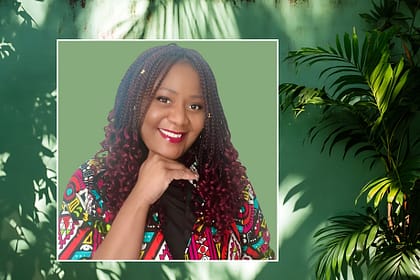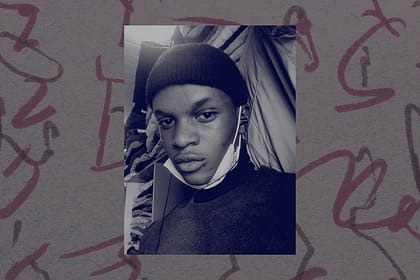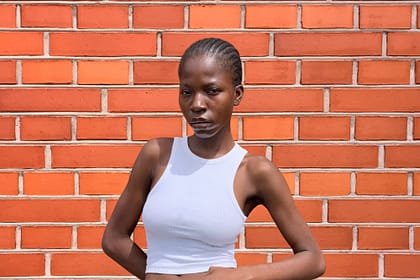Nigerian visual artist Olayinka Stephen Aragbada opens up about his creative journey, inspirations, and the power of art as both expression and healing. From his earliest fascination with comics and cartoons to his exploration of humanity’s essence through acrylics and charcoal, Olayinka shares the moments that shaped his artistic voice. He reflects on the struggles and resilience of Nigerians, the observant nature of children, and the role of storytelling in preserving history. Beyond technique, his works carry themes of identity, healing, and legacy, bridging the past, present, and future. Through this interview, Olayinka invites us into his world of art, where every piece is personal, every brushstroke is a confession, and every canvas tells a story worth remembering.
HANEEFAH: How did you start out as an artist? What’s your backstory?
OLAYINKA: My journey as an artist began in childhood when I developed a fascination with artworks, artists, and friends who could draw. As time went on, my curious mind prompted me to try my hand at drawing, including comics and cartoons. As I grew older, I realised that art was not only a passion but also an integral part of my identity. I discovered that I had a talent for it and became one of the best students in my art class, excelling in fine arts, which became my favourite subject.
Do you remember the first time you put a brush to canvas? What inspired it?
The first time I put a brush to canvas was a long time ago. Before that, I had been practising on paper and cardboard. This painting was inspired by my final-year project for my National Diploma at the Polytechnic of Ibadan, Oyo State, Nigeria. It was a challenging experience because painting on canvas is quite different from painting on paper.
When did you discover your passion for capturing the essence of humanity through your art, and what drives your fascination with “alluring humanity’s phenomena and its frozen moments”?
I discovered my passion for capturing the essence of humanity through my art when I began practising it full-time after university. As I started to understand life more fully and faced challenges both personally and through my observations of those around me, society, and the world, I developed an interest in documenting specific moments and events that are worth preserving. I strive to freeze these moments in time on canvas for viewers and future generations, especially as technology increasingly influences our natural human experiences.
What is the ideal geographical location for you to paint? Why?
The ideal geographical locations for my paintings are both national, in Nigeria, and international, in foreign lands. This diversity reflects the various cultures around the world.
What urban landscapes or everyday scenes inspired your piece Exhaustion 3 (Hustle), and how do you think it captures the struggles of Nigerians dealing with economic challenges?
Life of a daily worker, a hustler man that wasn’t built with a silver spoon but with the will to change the narrative for a better, great life for himself and his family, also for his coming generations to come. This is a scene of a man exhausted after work; this often occurs in our various environments to make a living. This shows how much effort good men put into growing their families.
Your pieces, ‘They Look and See,’ remind me of a novel titled ‘Big Small People.’ What inspired your pieces, ‘They Look and See’?
Children today are incredibly observant, often picking up on things we might not realise they notice. Their ability to pay attention to their surroundings, whether it’s in real life or online, is both impressive and sometimes concerning. There are various experiences, both positive and negative, that occur around them, which they absorb even if we think they are simply tuning out.
The difference between “looking” and “seeing” is important here. Looking is merely a physical observation without much significance or intention. In contrast, seeing involves actively observing with the intent to remember and understand. This deeper level of observation is what often surprises us about how kids behave; they mimic or react to things they’ve internalised.
This serves as a reminder to adults that our actions in front of children matter. They may seem like they aren’t paying attention, but they are. We should be mindful of what we do and say around them.
In 2024, you exhibited at a Black History Month exhibition BLVCK X organised by Nych Gallery. How have you used your artistic prowess to reflect the past, the present, and your emotions and connection to the world as a Black artist?
The works I exhibited in the show encompass the past, present, and future. These pieces address the need to step outside the programmed horizons of society and think outside the box. My artwork explores the concept of owning personal space as a man, as well as how men perceive women based on physical qualities. This issue is prevalent around the world. The pieces also highlight the importance of taking time to reboot and process life.
You know how the Blacks birthed music, rap, and poetry out of and in response to the pain of slavery in the years of slavery? Creativity was utilised in some way as a coping mechanism. How much does art help you heal? How many wounds do you think you have healed with art?
With my art, I know and believe that I have been able to heal people with my artworks from all over the world, who know me as an artist and see my artworks. My work’s connection is rooted in true human nature that resonates with any viewer. My works explore themes of the past and present, allowing me to create pieces that celebrate, remind, document, and encourage us, and bond us all as Africans, including Africans in the diaspora in general.
Would you describe your art style as confessional? Why?
My art style is confessional because it speaks directly to us all as humans. Regardless of colour, religion, or beliefs, the fact remains that we are all human.
What is the role of storytelling in your painting?
The role of storytelling in my artwork is very important. To talk about events from the past, the stories must be known so that I, as an artist, can immerse myself in those moments and use my imagination to capture and create something meaningful. This connection is particularly powerful when viewers have witnessed the event, experienced it, or are familiar with the story and its history.
Which of your pieces of art is the most personal to you?
Most of my pieces are personal to me because each of my pieces is a bit of me as an artist, my nature, the way I think, and my kind of spirit.
There are different methods of painting. Why did you settle on acrylic and charcoal?
I currently choose to work with charcoal and acrylics because these media best express my artistic temperament on canvas. They allow me to create paintings that capture events in my unique voice and style.
What is the most awkward form of inspiration you have ever had?
Painting events in the future, things that will definitely happen… to notify us in the present.
What is your greatest wish as an artist?
Hmmmm… being a living great, wealthy, successful artist known all over the world and having a great legacy to be remembered after God’s call back.








